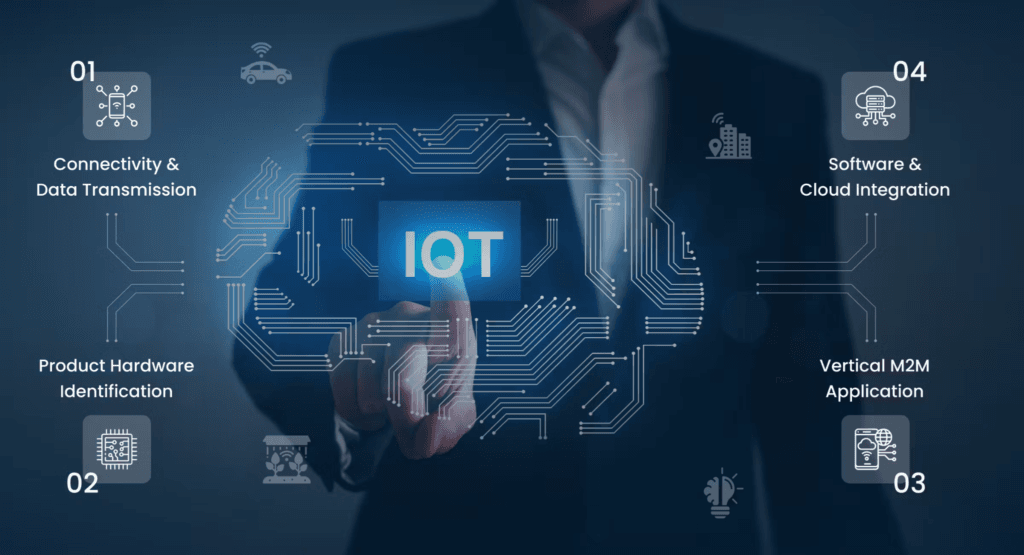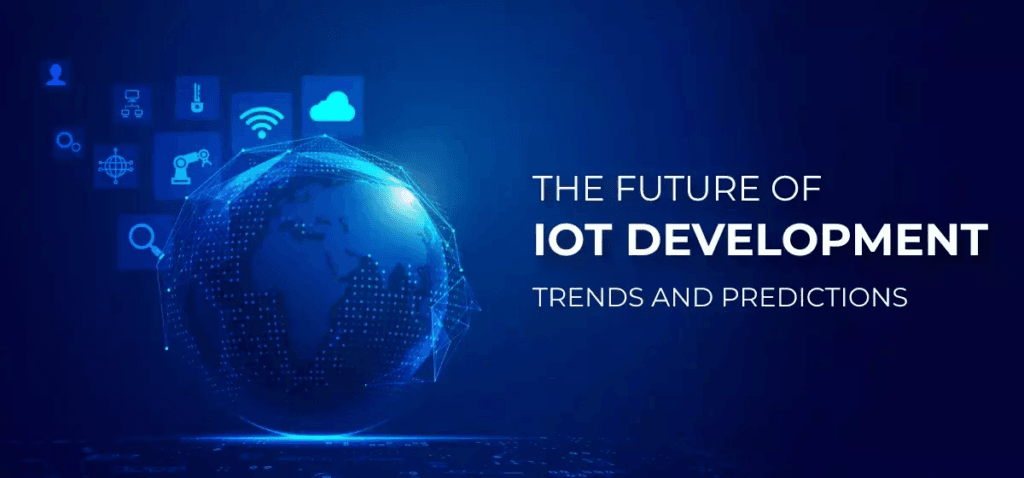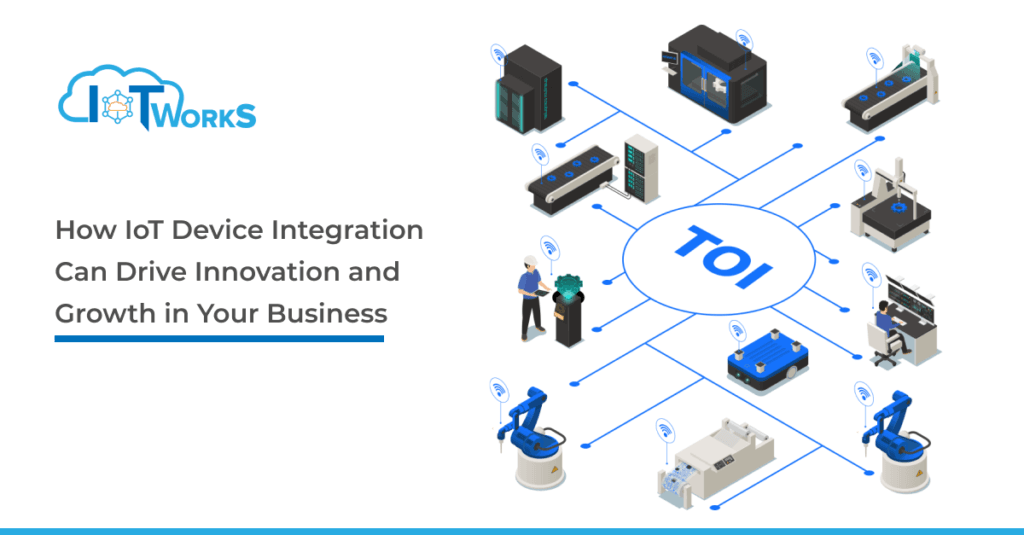IoT is revolutionising business operations, enabling innovative methods to drive innovation, efficiency, and growth—unprecedented until now. The global Internet of Things (IoT) market size was valued at USD 595.73 billion in 2023.
According to a report from Fortune Business Insights, the IoT market is projected to grow from USD 714.48 billion in 2024 to USD 4,062.34 billion by 2032, exhibiting a CAGR of 24.3% during the forecast period. Companies using IoT today are leading this digital transformation, leveraging new revenue streams, enhancing operational efficiency, and outpacing the competition.
Why Integrate Business Systems with IoT?

With IoT in your IT landscape, whether on-premise or in the cloud, IoT events can trigger all the workflows and business processes. These are new ways of improving massive operations and productivity in business. So, your teams can now engage in genuinely strategic and value-enhancing tasks and projects.
The magic begins when IoT device integration helps you collect and store massive amounts of data on the functioning of your machines and systems. But it is in actually linking IoT to other parts of your IT landscape—the apps, devices, machines, and systems—that the connection becomes more apparent.
Key Areas Where IoT is Driving Business Innovation
The IoT is revolutionising industries by driving unprecedented levels of innovation and efficiency. Let’s explore the key areas where IoT is making a transformative impact:
1. Enhanced Operational Efficiency
IoT devices can monitor and control equipment in real time to improve operational efficiencies. For example, in a manufacturing company, probable machine hindrance can be predicted by IoT sensors much in advance of undesirable downtimes, lowering maintenance costs and increasing productivity.
2. Data-driven Decision Making
The IoT will generate huge amounts of data through the data mechanism. When analysed, this data will give insights into business operations, optimise processes, and identify new areas of growth.
3. Improved Customer Experience
IoT devices can monitor and process information about customers to help companies offer them the required services and products. In the retail area, for instance, businesses may employ smart-shelf-embedded IoT sensors to monitor inventory level and customer preferences to realise targeted promotions and enhanced shopping experiences.
4. Supply Chain Optimisation
IoT devices are able to trace goods in transit and monitor an environment, all leading the supply chain towards transparency, thereby reducing delays and losses and ensuring products reach their destination in the best condition.
5. New Revenue Streams
IoT opens up new business model approaches and revenue streams. For instance, subscription-based services can be offered by companies for devices enabled with IoT or data monetisation from such devices through partnerships with other concurrently operating businesses.
6. Enhanced Security
IoT devices can enhance security; physical environments can be monitored with the help of these devices to discover threats. For instance, smart cameras and sensors can alert security with real-time analytics, detecting threats and restricting potential break-ins.
How to Integrate IoT into Your Business?

To effectively harness the power of IoT, it’s crucial to understand the steps involved in successful IoT device integration.
1. Identify Business Needs
The very first step to integrating IoT into your business will be to discern what specific needs or challenges exist in your business which IoT can help solve. It could be to attain operational efficiency, enhance customer experience, or bring more optimization in the supply chain.
2. Develop a Strategy
Once you’ve identified the business needs, develop a clear strategy for IoT device integration: defining the goals, selecting relevant IoT devices, and what types of data you will need to collect and analyze.
3. IoT Integration of Devices
The IoT device integration shall be effectual only if the IoT platform is correctly chosen. The platform needs to be scalable and secure to handle the volume of data coming from your IoT devices. Other prime considerations include ease of use and compatibility with existing systems, while real-time analytics capability is also an important factor of consideration.
4. Ensure Security and Compliance
IoT devices can be vulnerable to cyber threats, hence the need for robust security measures. These will include data encryption, the use of secure protocols for communication, and regular firmware updates. Also, ensure that the integration of your IoT devices is compliant with the relevant industry regulations and standards.
5. Train Your Team
The integration of IoT technology in your business requires engagement with your team. The team needs training on operations involving IoT devices, data interpretation, and decision-making from the data. This will assist your team in taking advantage of all the benefits associated with IoT.
6. Monitoring and Improvement
The performance and impact of the IoT devices on the business after their integration should be further monitored. Based on the data, identify where improvements may be needed and make changes to optimize the benefit of the IoT.
Challenges of IoT Integration
Although the benefits of IoT are significant, implementing IoT device integration into your business is not without its challenges. Some of these include:
- Data Management: IoT devices produce quite an enormous amount of data. A business needs to have the right tools and expertise to analyze and interpret this data effectively.
- Security Risks: IoT devices tend to be more prone to cyber-attacks, and the more you are connected, the higher the risk. Ensuring that strong security measures can help in safeguarding your business.
- Cost: The initial and infrastructural costs needed to support most IoT devices are very high. Long-run benefits normally outweigh the initial investment.
- Integration with existing systems: Integration of IoT devices with present business systems happens to be very intricate and may involve too much time and resources. Proper expertise that supports the plan for smooth integration should be available.
The Future of IoT in Business

Indeed, technological advancements are being pursued with even more innovations, so the future of IoT for businesses is bright. In addition, with the increased deployment of 5G networks, the pace and reliability of the connected IoT will improve drastically, thus allowing real-time processing and decision-making. What is more, advanced AI and machine learning will further enhance the capabilities of IoT devices to predict trends, automate processes, and make more intelligent decisions.
The companies embracing IoT in the times to come would, therefore, be better positioned to innovate, grow, and further compete in the digital era. This is because the power of connected devices could be leveraged by businesses for opening up newer avenues, improving efficiency, and creating value for customers.
Harness the Power of IoT to Streamline Operations
Integrating IoT into your enterprise will drive innovation, enhance operational efficiency, and unlock new revenue streams. But successfully accomplishing this requires careful planning, the right technology, and, most importantly, focusing on security. With a strategic approach to the IoT, companies can set themselves up for long-term growth and success in an increasingly connected world.
Emerging and innovative technology, such as IoT and Generative AI, may transform businesses across verticals. Be it manufacturing, insurance, retail, banking, or healthcare, any enterprise can integrate modern IoT solutions from IoT-WorkS into its systems and applications to smoothen workflows and accelerate productivity and business revenue.
FAQs
1. Which industries is IoT integration most beneficial to?
The major beneficiaries of IoT device integration include manufacturing, retail, healthcare, logistics, and energy, among other industries that are still emerging because of the efficiency, real-time monitoring, and data-driven insights provided by the IoT.
2. How can small businesses, then, afford to integrate the IoT?
Small businesses can begin with scalable IoT solutions that match their budget and later expand as returns on the investment are experienced. Most cloud-based IoT platforms are designed to be affordable for even smaller enterprises because their pricing models are flexible.
3. What are the major security concerns about IoT devices?
The major concerns of an IoT device have to do with data breach, unauthorized access to data, and vulnerabilities in device firmware. Major concern: Hence, proper encryption, updating of the firmware, and use of secure communication protocols help mitigate the risk.
